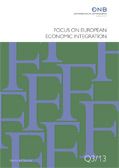Focus on European Economic Integration Q3/22
 OeNB
OeNB
- Erschienen:
- August 2022
 OeNB
OeNB
Call for applications: Klaus Liebscher Economic Research Scholarship (PDF, 76 kB) en 22.08.2022, 00:00:00
The role of public services quality in shaping migration intentions in Central, Eastern and Southeastern Europe (PDF, 1 MB) Raggl. What role does the quality of public services play in shaping migration intentions? Using OeNB Euro Survey data collected in 2018, we study the impact of individual perceptions of public services quality on individuals’ migration intentions in ten Central, Eastern and Southeastern European (CESEE) countries. We apply ordinary least squares (OLS) as well as instrumental variable (IV) estimations, using externally merged infrastructure-related variables and individuals’ opinions on the adequacy of public spending on services as instrumental variables. Our findings suggest that dissatisfaction with the quality of public services in the home countries increases the likelihood of individuals having migration intentions. Broken down by the type of public service, we find that dissatisfaction with social security, health, public infrastructure and with services that target businesses and regional development is associated with higher migration aspirations. Furthermore, for people with young children, we see a higher effect on migration intentions resulting from dissatisfaction with education, health and public safety. For self-employed individuals, the effect of dissatisfaction with public services that address companies and regional development is particularly important. The results further confirm that sociodemographic characteristics, economic factors and network effects are closely associated with the aspiration to move abroad. en migration intentions, quality of public services, Central, Eastern and Southeastern Europe J61, F22, O52 22.08.2022, 00:00:00
The e-motion of car manufacturing in CESEE: the road ahead
(PDF, 1,1 MB)
Slacík.
Central, Eastern and South-Eastern European (CESEE) countries have benefited considerably from the grand-scale relocation of car production sites to emerging markets over the last two decades. On the back of strong foreign direct investment, the automotive industry has thus become a major economic pillar in several countries and firmly integrated into global, predominantly European, value chains. More recently, the automotive industry has seen some challenging times, though. Global and particularly European car production has been losing steam, and the industry has been hit by major black swan events, most painfully the coronavirus pandemic and Russia’s invasion of Ukraine. What is more, the global automotive industry has been undergoing unprecedented structural shifts on the demand and supply side, such as autonomous driving, shared mobility, connectivity and, most notably, the transition to electric vehicles.
Against the background of these great changes and challenges, the present paper explores the emergence of the largely foreign-owned automotive industry in CESEE and its level of preparedness for managing the risks and uncertainties and seizing the opportunities implied by the ongoing development of the automotive industry. After collecting and analyzing relevant qualitative information we find that the CESEE car industry will be walking a thin line between adopting new technologies and sticking to the internal combustion engine for longer than Western countries. For CESEE countries to maximize the benefits and minimize the risks of the technological transformation in the car industry the key priority is to preserve close links with Germany, stay tuned for battery production and focus on activities and promising industries with higher value added.
en
automotive, electric, battery, transformation, CESEE
F15, F60, L62
22.08.2022, 00:00:00
Russia’s large fintechs and digital ecosystems – in the face of war and sanctions (PDF, 696 kB) Allinger, Barisitz, Timel. Russia’s financial landscape has changed rapidly in recent years, with the lines between banks and tech firms ever more blurring and giving rise to large fintech firms. We are going to look at these changes from a perspective before and after Russia’s invasion of Ukraine in February 2022. Pre-war, tech firms such as Yandex or VK and financial firms such as Sberbank started diversifying into each other’s business by broadening service offers to consumers via so-called digital ecosystems. From an international perspective, two things stand out: first, with Sberbank, Russia’s largest bank is attempting to fully rebrand itself as a technology company. Second, the Russian government facilitates these developments both directly and indirectly, e.g. by pushing the country’s digital transformation while simultaneously exercising more control over foreign tech firms. From a post-invasion perspective, international sanctions pose several challenges to large fintech firms; and so do economic and geopolitical developments. Going forward, the firms will face major issues in advancing their digital ecosystems. As to technology-related sanctions, we show that Russia continues to substantially depend on technologies from abroad, despite pre-war efforts to reduce this dependence. Russia’s economy in general and its tech and fintech firms in particular are thus vulnerable to international technology sanctions. As to sanctions evasion, particularly through crypto assets, we currently see limited potential for circumvention. Clearly, sanctioning countries need to perceive sanctions as a dynamic tool that they must adjust regularly to address potential loopholes and circumvention tactics. en fintech, digital ecosystems, Russia, sanctions G20, G28, O30, F51 22.08.2022, 00:00:00